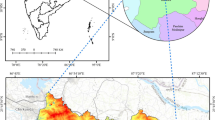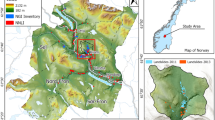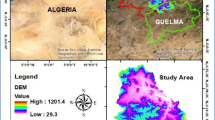Abstract
Urban easily waterlogged districts need more systematic monitoring as the key disaster-forming and managing spatial scale, hard to identify the early-warning precipitation (EP). We proposed new algorithms to extract the urban easily waterlogged hilly and plain districts’ polygons in Jiangxi Province, China. The districts’ disaster risk level prediction model was built through eleven intelligent algorithms’ optimization based on the field survey data. The multi-period EP values were identified using the scenario simulation by the model and further verified compared to the government-issued ones. It indicated that 532 easily waterlogged districts possessed sufficient sample representativeness, represented by the significant coefficient of variation ≥ 0.66 for slope, waterlogging disaster area, and depth. The fine Gaussian support vector machine and fine K-Nearest Neighbor algorithms performed higher prediction accuracies of more than 86% and 83% in the model construction and verification districts, respectively. The 1-, 3-, and 6-h severe waterlogging disaster’s EP medians were averaged to be 16.5–20.8, 31.5–35.8, and 35–39.3 mm differed among the optimum algorithms respectively, smaller than the government-issued ones. In comparison, the 1-, 3-, and 6-h moderate waterlogging disaster’s EP medians were averaged to be 10.5–16.1, 25.5–31.1, and 29–34.6 mm respectively, larger than the issued ones.






Similar content being viewed by others
Data availability
The authors do not have permission to share data.
References
Alfere S, Maghari AY (2018) Prediction of student’s performance using modified KNN classifiers. In: 1st International Conference on Engineering & Future Technology (ICEFT 2018). University of Palestine, Gaza, Palestine, pp 143-150. https://www.researchgate.net/publication/324941826
Ali AH, Alrubei MAT, Falah L, Hassan M, Al-Ja’afari M, Abdulwahed SH (2020) Diabetes classification based on KNN. IIUM Eng J 21(1):175–181. https://doi.org/10.31436/iiumej.v21i1.1206
Almutairi ES, Abbod MF (2023) Machine learning methods for Diabetes prevalence classification in Saudi Arabia. Modelling 4(1):37–55. https://doi.org/10.3390/modelling4010004
Assegie TA, Suresh T, Purushothaman R, Ganesan S, Kumar NK (2023) Early prediction of gestational diabetes with parameter-tuned K-Nearest Neighbor Classifier. J Robot Control 4(4):452–457. https://doi.org/10.18196/jrc.v4i4.18412
Awad M, Khanna R (2015) Support vector machines for classification. In: Efficient Learning Machines. Apress, Berkeley, CA. https://doi.org/10.1007/978-1-4302-5990-93
Balstrm T, Crawford D (2018) Arc-Malstrm: A 1D hydrologic screening method for stormwater assessments based on geometric networks. Comput Geosci 116:64–73. https://doi.org/10.1016/j.cageo.2018.04.010
Berkhahn S, Fuchs L, Neuweiler I (2019) An ensemble neural network model for real-time prediction of urban floods. J Hydrol 575:743–754. https://doi.org/10.1016/j.jhydrol.2019.05.066
Casal-Campos A, Sadr SMK, Fu G, Butler D (2018) Reliable, resilient and sustainable urban drainage systems: an analysis of robustness under deep uncertainty. Environ Sci Technol 52(16):9008–9021. https://doi.org/10.1021/acs.est.8b01193
Chen H, Hu S, Hua R, Zhan X (2021) Improved naive Bayes classification algorithm for traffic risk management. EURASIP J Adv Signal Process 2021(1):1–12. https://doi.org/10.1186/s13634-021-00742-6
Chen J, Li Y, Zhang S (2023) Impact of different design rainfall pattern peak factors on urban flooding. Water 15(13):2468. https://doi.org/10.3390/w15132468
Connelly L (2020) Logistic regression. Medsurg Nursing 29(5):353–354
Deng C, Liu P, Wang D, Wang W (2018) Temporal variation and scaling of parameters for a monthly hydrologic model. J Hydrol 558:290–300. https://doi.org/10.1016/j.jhydrol.2018.01.049
Elga S, Jan B, Okke B (2015) Hydrological modelling of urbanized catchments: a review and future directions. J Hydrol 529:62–81. https://doi.org/10.1016/j.jhydrol.2015.06.028
Felder G, Zischg A, Weingartner R (2017) The effect of coupling hydrologic and hydrodynamic models on probable maximum flood estimation. J Hydrol 550:157–165. https://doi.org/10.1016/j.jhydrol.2017.04.052
Guo Y, Li Y, Wang H, Hu Yu (2022a) Research on the meteorological and hydrological coupling models on early warning of urban waterlogging in Zhengzhou. J China Hydrol 42(4):61–67 (In Chinese)
Guo Y, Quan L, Song L, Liang H (2022b) Construction of rapid early warning and comprehensive analysis models for urban waterlogging based on AutoML and comparison of the other three machine learning algorithms. J Hydrol 605:127367. https://doi.org/10.1016/j.jhydrol.2021.127367
Hu M, Zhang X, Siu YL, Li Y, Tanaka K, Yang H, Xu Y (2018) Flood mitigation by permeable pavements in Chinese sponge city construction. Water 10(2):172. https://doi.org/10.3390/w10020172
Huang C, Chen Y, Zhang S, Wu J (2018) Detecting, extracting, and monitoring surface water from space using optical sensors: a review. Rev Geophys 56(2):333–360. https://doi.org/10.1029/2018RG000598
Huang H, Zhang L, Liu L, Wang X, Wang X, Pan C, Wang D (2019) Assessing the mitigation effect of deep tunnels on urban flooding: a case study in Guangzhou, China. Urban Water J 16(4):312–321. https://doi.org/10.1080/1573062X.2019.1669186
Huang S, Hattermann FF (2018) Coupling a global hydrodynamic algorithm and a regional hydrological model for large-scale flood inundation simulations. Hydrol Res 49(2):438–449. https://doi.org/10.2166/nh.2017.061
Huang T, Chen J, Huang F, Su Z (2017) A study of urban waterlogging characteristics in Pearl River delta region based on GIS. J Guangdong Univ Technol 34(1):24–30. https://doi.org/10.12052/gdutxb.160102
Ji H, Huang S, Wu Y, Hui Z, Zheng C (2019) A new weighted naive Bayes method based on information diffusion for software defect prediction. Software Qual J 27:923–968. https://doi.org/10.1007/s11219-018-9436-4
Jiang F, Smith AR, Kutia M, Wang G, Liu H, Sun H (2020) A modified KNN method for map** the leaf area index in arid and semi-arid areas of China. Remote Sens 12:1884. https://doi.org/10.3390/rs12111884
Jiao S, Zhang X, Xu Y (2017) A review of Chinese land suitability assessment from the rainfall-waterlogging perspective: evidence from the Su Yu Yuan area. J Clean Prod 144:100–106. https://doi.org/10.1016/j.jclepro.2016.12.162
Johnson JM, Yadav A (2018) Fault detection and classification technique for HVDC transmission lines using KNN. Int Conf ICT Sustain Dev (Singapore). https://doi.org/10.1007/978-981-10-3920-1_25
Khatri S, Kokane P, Kumar V, Pawar S (2022) Prediction of waterlogged zones under heavy rainfall conditions using machine learning and GIS tools: a case study of Mumbai. GeoJournal 2022(1):1–15. https://doi.org/10.1007/s10708-022-10731-3
Lai C, Chen X, Chen X, Wang Z, Wu X, Zhao S (2015) A fuzzy comprehensive evaluation model for flood risk based on the combination weight of game theory. Nat Hazards 77:1243–1259. https://doi.org/10.1007/s11069-015-1645-6
Li B, Zhao Y, Fu Y (2015) Spatio-temporal characteristics of urban storm waterlogging in Guangzhou and the impact of urban growth. J Geo-Inf Sci 17(4):445–450. https://doi.org/10.3724/SP.J.1047.2015.00445
Li H, Lei X, Shang Y, Qin T (2018) Flash flood early warning research in China. Int J Water Resour D 34(3):369–385. https://doi.org/10.1080/07900627.2018.1435409
Liu F, Liu X, Xu T, Yang G, Zhao Y (2021) Driving factors and risk assessment of rainstorm waterlogging in urban agglomeration areas: a case study of the Guangdong-Hong Kong-Macao Greater Bay Area, China. Water 13(6):770. https://doi.org/10.3390/w13060770
Liu J, Pei Y, Mei C, Liu C (2023) Waterlogging cause and disaster prevention and control of “7·20” torrential rain in Zhengzhou. J Zhengzhou Univ (Eng Sci) 44(2):38–45. https://doi.org/10.13705/j.issn.1671-6833.2023.02.019. (In Chinese)
Liu Z, Qin Z, Luo X, Zhou F, Zhang J (2019a) Stellar spectra classification by support vector machine with spectral distribution properties. Spectrosc Spect Anal 39(4):1307–1311. https://doi.org/10.3964/j.issn.1000-0593(2019)04-1307-05. (in Chinese)
Liu Z, Zhang H, Liang Q (2019b) A coupled hydrological and hydrodynamic model for flood simulation. Hydrol Res 50(2):589–606. https://doi.org/10.2166/nh.2018.090
Ma B, Wu Z, Wang H, Guo Y (2020) Study on the classification of urban waterlogging rainstorms and rainfall thresholds in cities lacking actual data. Water 12(12):3328. https://doi.org/10.3390/w12123328
Palla A, Gnecco I (2015) Hydrologic modeling of Low Impact Development systems at the urban catchment scale. J Hydrol 528:361–368. https://doi.org/10.1016/j.jhydrol.2015.06.050
Pan X, Hou J, Chen G, Zhou N, Lv J, Liang X, Tang J, Zhang S (2023) Rapid forecasting of urban waterlogging based on K-nearest neighbor and hydrodynamic model. Water Resour Prot 39(3):91–100. https://doi.org/10.3880/j.issn.1004-6933.2023.03.011 (InChinese)
Roy S, Bose A, Singha N, Basak D, Chowdhury IR (2021) Urban waterlogging risk as an undervalued environmental challenge: an integrated MCDA-GIS based modeling approach. Environ Chall 4(5):100194. https://doi.org/10.1016/j.envc.2021.100194
Savas C, Dovis F (2019) The impact of different Kernel functions on the performance of scintillation detection based on support vector machines. Sensors 19:5219. https://doi.org/10.3390/s19235219
Shao W, Li Y, Yan D, Liu J, Yang Z, Yang Z (2019) Analysis of the losses due to flood and waterlogging disasters in China during 2006 to 2017. Proc 7(1):25. https://doi.org/10.3390/ECWS-3-05820
Shipe ME, Deppen SA, Farjah F, Grogan EL (2019) Develo** prediction models for clinical use using logistic regression: an overview. J Thorac Dis 11(S4):S574–S584. https://doi.org/10.21037/jtd.2019.01.25
Sun S, Zhai J, Li Y, Huang D, Wang G (2020) Urban waterlogging risk assessment in well-developed region of Eastern China. Phys Chem Earth, Parts A/B/C 115:102824. https://doi.org/10.1016/j.pce.2019.102824
Tang X, Li J, Liu W, Yu H, Wang F (2021) A method to increase the number of positive samples for machine learning-based urban waterlogging susceptibility assessments. Stoch Env Res Risk A 36:2319–2336. https://doi.org/10.1007/s00477-021-02035-8
Tehrany MS, Jones S, Shabani F (2019) Identifying the essential flood conditioning factors for flood prone area map** using machine learning techniques. CATENA 175:174–192. https://doi.org/10.1016/j.catena.2018.12.011
Tibaduiza D, Torres-Arredondo MÁ, Vitola J, Anaya M, Pozo F (2018) A damage classification approach for structural health monitoring using machine learning. Complexity 2018:5081283. https://doi.org/10.1155/2018/5081283
Tran D, Xu D, Dang V, Alwah AAQ (2020) Predicting urban waterlogging risks by regression models and internet open-data sources. Water 12(3):879. https://doi.org/10.3390/w12030879
Wahab AHBA, Zahari R, Lim TH (2019) Detecting diseases in chilli plants using K-means segmented support vector machine. 2019 3rd International Conference on Imaging, Signal Processing and Communication (ICISPC) (Singapore). https://doi.org/10.1109/ICISPC.2019.8935722
Wang J, Sun X, Cheng Q, Cui Q (2021a) An innovative random forest-based nonlinear ensemble paradigm of improved feature extraction and deep learning for carbon price forecasting. Sci Total Environ 762:143099. https://doi.org/10.1016/j.scitotenv.2020.143099
Wang Y, Cao X, Li Y (2022) Unsupervised outlier detection for mixed-valued dataset based on the adaptive k-Nearest neighbor global network. IEEE Access 10:32093–32103. https://doi.org/10.1109/ACCESS.2022.3161481
Wang Y, Zhai J, Song L (2021b) Waterlogging risk assessment of the Bei**g-Tian**-Hebei urban agglomeration in the past 60 years. Theor Appl Climatol 145:1039–1051. https://doi.org/10.1007/s00704-021-03670-5
Wijayanto I, Rizal A, Humairani A (2019) Seizure detection based on EEG signals using Katz fractal and SVM classifiers. 2019 5th International Conference on Science in Information Technology (Yogyakarta, Indonesia). https://doi.org/10.1109/ICSITech46713.2019.8987487
Wu J, Lin K, Liu M, Huang L (2023) Discussion on flood hazard and causes analysis in coastal areas by using the Apriori Algorithm. China Rural Water Hydropower 5:1–13 (In Chinese)
Wu X, Yu D, Chen Z, Wilby R (2012) An evaluation of the impacts of land surface modification, storm sewer development, and rainfall variation on waterlogging risk in Shanghai. Nat Hazards 63:305–323. https://doi.org/10.1007/s11069-012-0153-1
**ao Y, Li B, Gong Z (2018) Real-time identification of urban rainstorm waterlogging disasters based on Weibo big data. Nat Hazards 94:833–842. https://doi.org/10.1007/s11069-018-3427-4
**ong L, Yao Y (2021) Study on an adaptive thermal comfort model with K-nearest-neighbors (KNN) algorithm. Build Environ 202:108026. https://doi.org/10.1016/j.buildenv.2021.108026
Xu M, Liu S, Sun Y, Yao Y (2020) Rapid identification and early warning of urban waterlogging risk using flooding model. Geomat Inform Sci Wuhan Univ 45(8):1185–1194. https://doi.org/10.13203/j.whugis20200122. (In Chinese)
Yang F, Duan Y, Pan Y, Li X (2018) Study on impending early-warming indicators of urban waterlogging in Kunming. Yunan Geogr Environ Res 30(4):64–69 (in Chinese)
Yang X, Zhang Y, Zhou D, Ji Y, Song X, Li D, Zhu Z, Wang Z, Liu Z (2023) Drilling conditions classification based on improved stacking ensemble learning. Energies 16(15):5747. https://doi.org/10.3390/en16155747
Yao L, Wei W, Yu Y, **ao J, Chen L (2018) Rainfall-runoff risk characteristics of urban function zones in Bei**g using the SCS-CN model. J Geogr Sci 28:656–668. https://doi.org/10.1007/s11442-018-1497-6
Yuan C, Yang L (2021) Capped L2, p-norm metric based robust least squares twin support vector machine for pattern classification. Neural Netw 142:457478. https://doi.org/10.1016/j.neunet.2021.06.028
Zhang F, Yang X (2020) Improving land cover classification in an urbanized coastal area by random forests: the role of variable selection. Remote Sens Environ 251:112105. https://doi.org/10.1016/j.rse.2020.112105
Zhang Q, Wu Z, Tarolli P (2021) Investigating the role of green infrastructure on urban waterlogging: evidence from metropolitan coastal cities. Remote Sens 13(12):2341. https://doi.org/10.3390/rs13122341
Zhang Q, Wu Z, Zhang H, Fontana GD, Tarolli P (2020) Identifying dominant factors of waterlogging events in metropolitan coastal cities: the case study of Guangzhou, China. J Environ Manage 271:110951. https://doi.org/10.1016/j.jenvman.2020.110951
Zhang Q, **ao M, Liu C, Singh VP (2014) Reservoir-induced hydrological alterations and environmental flow variation in the East River, the Pearl River basin, China. Stoch Environ Res Risk Assess 28:2119–2131. https://doi.org/10.1007/s00477-014-0893-4
Zhang S, Pan B (2014) An urban storm-inundation simulation method based on GIS. J Hydrol 517:260–268. https://doi.org/10.1016/j.jhydrol.2014.05.044
Zhang Z, Zhang Q, Singh VP, Shi P (2018) River flow modelling: comparison of performance and evaluation of uncertainty using data-driven models and conceptual hydrological model. Stoch Environ Res Risk Assess 32:2667–2682. https://doi.org/10.1007/s00477-018-1536-y
Zhong H, Zhang B, Ma T, Qi X, Wang X, Shang H, Qu S, Fang W (2022) Flood scenario simulation, based on the hydrological and hydrodynamic model in the Puyang River Catchment. Water 14(23):3873. https://doi.org/10.3390/w14233873
Zou Q, Zhou J, Zhou C, Song L, Guo J (2013) Comprehensive flood risk assessment based on set pair analysis-variable fuzzy sets model and fuzzy AHP. Stoch Environ Res Risk Assess 27:525–546. https://doi.org/10.1007/s00477-012-0598-5
Acknowledgements
This work was sponsored by Jiangxi Provincial Key Research and Development Program (20212BBG71014), the Key Program for the Jiangxi Provincial Hydraulic Science and Technology Projects (202224ZDKT18), the Key science and technology project of Jiangxi Province (20213AAG01012) and Science and Technology Project for the Education Department of Jiangxi Province (GJJ190973; GJJ2201510).
Author information
Authors and Affiliations
Contributions
The contribution of **nfa Xu presents the proposed hypothesis and design of the research framework. Hua Bai, Bingxiang Wang, Feng xiao are responsible for data analysis and writing paper. Bin Li, Zhangjun Liu, Yang Zhang, Zhenyu Wen, and Yongfeng Huang are responsible for the data collection and quality control.
Corresponding author
Ethics declarations
Competing interests
The authors declare no competing interests.
Additional information
Publisher's Note
Springer Nature remains neutral with regard to jurisdictional claims in published maps and institutional affiliations.
Rights and permissions
Springer Nature or its licensor (e.g. a society or other partner) holds exclusive rights to this article under a publishing agreement with the author(s) or other rightsholder(s); author self-archiving of the accepted manuscript version of this article is solely governed by the terms of such publishing agreement and applicable law.
About this article
Cite this article
Bai, H., Wang, B., Li, B. et al. Multi-period early-warning precipitation identification method for the easily waterlogged districts in Jiangxi province, China. Theor Appl Climatol 155, 2705–2718 (2024). https://doi.org/10.1007/s00704-023-04774-w
Received:
Accepted:
Published:
Issue Date:
DOI: https://doi.org/10.1007/s00704-023-04774-w




